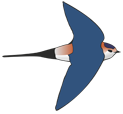Autumn Report 2015
by Dries Engelen & Aki Aintila
BRC continued its monitoring work with another successful season studying the raptor migration in the Batumi bottleneck. In autumn 2015 we managed to count a total of 1.029.478 raptors without double counts! Reaching the million threshold again for the fourth year in a row is an important milestone for the migration count. The creation and fine-tuning of the bird migration app of trektellen was a big success and we have had great advantages by using this app on tablets for data recording. Striking this season was the early passage of Honey Buzzards and a low Steppe Buzzard count due to warm cloudless end of the season. Also remarkable is the continuing increase of Black Kite and Osprey totals. Read on for more insights!
Volunteers scanning from station 1. Photo by Johannes Jansen.
Figure 1 below shows the autumn phenology of all raptors. The count stations were not occupied on only a few days this year due to heavy thunderstorms. When looking the previous years in figure 2 we can say 2015 was a relatively good year for raptor migrants at least spoken in terms of flight concentration, but we obviously recorded fewer raptors than the last two seasons.
Figure 1: Autumn 2015 migration phenology of all raptors.
Figure 2: Raptor Migration Autumn Totals 2008 - 2015
European Honey Buzzard adult male actively moulting the inner primaries. Photo by Johannes Jansen.
During the very first days of the count we started getting high daily totals of Honey Buzzards and thus expected to have the first migration peak relatively early in the season. And so we had. In 2015 the peak migration of Honey Buzzards was on 27th August with over 110,000(!), one of our top five migration days since 2008. What’s more, we counted over 250,000 Honey Buzzards between 26th and 28th August. Compared to previous years the peak migration came early, on average 7 days earlier.. Furtherone the season we didn't get any more peak days but continuous migration till mid-September pushed the eventual total autumn number (586,146) far above the average (501,619). We put together the years 2012-2015 in a phenology graph (figure 3) to show how different the migration was compared to other years.
Figure 3: Autumn phenology for European Honey Buzzard migration 2012 - 2015
Midway through the season, Black Kites broke the season total record with 125,284 individuals, again far above the average (91,847) and also a new day record with over 25,000 birds! Booted Eagles showed strong migration once again, with the peak migration of nearly 800 birds on 16th September followed by day totals of roughly 600 and 500 individuals, for a season total of 6,898. Towards the end of the season, we were anticipating the peak migration of Steppe Buzzards.
Slow motion footage of Steppe Buzzard migration over station 2 in Batumi, Shuamta. Video by Jasper Wehrmann.
Halfway September, we were already enjoying a phenomenal early migration of large eagles. We were especially picking up relatively good numbers of Greater Spotted and Steppe Eagles. This is a hard undertaking despite having greatly increased our proficiency in field identification of subadult and adult eagles. It’s something you definitely prefer to do under better light conditions than we usually enjoy in Batumi. But our efforts resulted in the identification of record numbers of adult birds! It was a clear sign of increasing skills but doesn't say much about age class differences in migration yet. We will continue to train counters in eagle identification, every single year! In total around 7,800 large eagles were tallied. Of those, 55% were identified as Lesser Spotted, 5% as Greater Spotted and 6% as Steppe Eagles. Still the total numbers for large eagles was much lower than in the two previous years.
Steppe Eagle subadult 5cy. Photo by John Wright.
Eastern Imperial Eagle adult. Photo by John Wright.
Greater Spotted Eagle immature, 2cy. Photo by John Wright.
August and September were exceptionally dry and hot and we rarely had the typical migration weather in Batumi which has brought so many raptors in the last years to the coastal local flyway. Rain was absent for many days and so were the important clouds over the mountains. Then mid and end of October when rain was coming and flooding the roads the hopes were high.
5th October was the day that most volunteers will remember from this season. For a few days already, we were witnessing an increasing Steppe Buzzard migration and just on the previous day 48,000 Steppe Buzzards passed our count stations. On the 5th, we counted more than 10,000 birds during the first few hours of the day. After that, we started to wait for new birds, and in the early afternoon we were rewarded. Located just a few dozen kilometres north of Batumi, Rafa Benjumea reported a huge wave of raptors streaming in from the mountains, and the cloud-choked hills to our east would funnel them directly towards us.
Steppe Eagle immature 2cy. Photo by John Wright.
For the next few hours people on both count stations witnessed migration frenzy. It was hectic, yet addictive, and every bird was counted and data carefully recorded. From the Steppe Buzzard masses, we were constantly picking up sweeties like juvenile Imperial Eagles, adult Egyptian Vulture, Steppe Eagles of different plumages and a fulvescens-type Greater Spotted Eagle. Another mind-blowing sighting was an adult Imperial Eagle, which literally dropped some of the people to their knees.
Greater Spotted Eagle fulvescens type. Photo by John Wright.
Count coordinators were following the accumulating numbers of counted raptors all the time, and once we hit the needed number, the announcement was made that BRC had once again reached the total of 1 million migrating raptors! After the cheers, hugs and laughs, we continued the count and reached a day total of over 32,000 raptors. Not the biggest day of the season, but certainly a remarkable one. We finished the day gathering at the Green Café and celebrating another great achievement and the great team we had during the season.
Group photo BRC count volunteers and visitors. Photo by Guille Mayor.
Group photo BRC count volunteers and visitors. Photo by Daniel Hinckley.
Once the threshold was reached, overall migration calmed down since the infamous rains had reached Batumi. The last two weeks of the count were a bit fragmented, since we couldn’t conduct a proper count every day due to the weather conditions. During the clear days we got what we expected and enjoyed really nice migration of large eagles without the Steppe Buzzard stress. On those days we spotted the first Griffon Vulture and Golden Eagle for the season.
The last part of the season culminated in the last day of the count. We delayed the start for a few hours, but once the rain eased up and skies cleared, we headed to our count posts and finished the season with a quality day, including 7 Imperial Eagles of which two were adult birds. As the first bird this season that we recorded to our “Palmtop” was an Osprey, on the last day the last recorded bird was a female-coloured Merlin. Speaking of Ospreys, this beautiful species broke the season record – again – as we counted 150 Ospreys during the season.
Harriers added up to 18,700, which is another great and high number. Marsh Harriers boasted 8984 individuals. Ringtail harriers were less numerous this season than on average, as we counted 3356 Montagu’s Harriers, 794 Pallid Harriers plus 5629 unidentified (Montagu’s / Pallid) Harriers. Memorable was when within 15 minutes more than 400 ringtail harriers migrated over Station 1 on 28th Aug, proving that harrier migration in Batumi is still second to none.
Pallid Harrier female 2cy. Photo by John Wright.
Marsh Harrier adult male dark morph. Photo by John Wright.
From the less-numerous species, Saker Falcon was observed twice. Oriental Honey Buzzard is a species that almost every newcomer to Batumi wants to see, and this season we observed a total of 28 individuals. Also commonly referred to as Crested Honey Buzzard, this species has become a regular, though scarce, migratory bird in the Batumi bottleneck since 2012. However, we have to beware of potential candidates to carefully analyze the photos, as those often reveal to be Eurasian Honey buzzards or even hybrids. They are tricky to ID correctly and in most cases require a good photo to confirm the species identification.
Oriental Honey Buzzard adult male. Photo by John Wright.
The daily count results and totals for this season can be found online. The numbers differ slightly from those presented here, because they are raw numbers including double counts. But the advantage is that you can select the totals per station, which is a nice feature when exploring migration in Batumi:
Along the species we observe every year, we were once again blessed with rarities to give us another varied season. Probably the best sighting from our watchpoint was a Cinereous Vulture that stormed out of the clouds on 26th Sept. This species was last seen on our count during 2012. Another mind-blowing bird was the juvenile White Pelican that migrated with a group of Black Kites on 19th Sept. And another remarkable observation was a Rough-legged Buzzard, which only the second record over Batumi, ever.
Rough-legged Buzzard at Batumi. Photo by Demetrios Bertzeletos.
The bird below caught our attention and we still are a bit uncertain about its identification as menetriesi or vulpinus.
Buteo spec. Photo by Daniel Hinckley.
Spending two months counting raptor migration allowed the team to observe a total of 32 different raptor species! Along with the high variety of plumages, the variation in species is in itself remarkable. Batumi offers everything a raptor counter could hope for: huge numbers of birds, beautiful plumages and identification challenges that puzzle even the top ID specialists.
The nearby Chorokhi Delta proved itself as a birding hotspot and the most popular location for volunteer counters to spend their days off. The true MEGA of the season was found on 2nd October by Mikel Salvador, Theo Askov and Johannes Silvonen, when the group reported a male Black-Crowned Sparrow-Lark from the delta’s seashore! Other amazing reported birds were Great Spotted Cuckoo on 6th and 11th August, Pacific Golden Plover 24th September and two Daurian Shrikes (1st and 9th October). An almost annual Sociable Plover was spotted, several birders were lucky to find Purple Swamphen, and this year was special for different crake species as well. Unfortunately, august and september were exceptionally dry, so this year most songbird migration went over and there was no rain that forced them on the ground in Batumi. We haven't seen so few songbirds there before. But end of october finally the rain came in, and many songbirds came and even brought some new species to Batumi and Georgia even. The Dutch ringing team did a great job with checking bushes every single day and eventually found quite good stuff at the end.
After another amazing season, warm thanks and acknowledgements should go to all the people who contributed to this count. Results like this would not be possible without the dedicated volunteers working long days on the count stations. Special thanks to count coordinators Charly Robinet, Aki Aintila, Jasper Wehrmann, Dries Engelen and Rafa Benjumea who took care of the quality of the count and the comfort of the volunteers. Also special thanks to Daniel Hinckley, Aurélie Chaput and Gabriel Caucal for working with us the whole season. Together with Dries and Rafa, Simon Cavaillès worked hard to pull the monitoring team together and to arrange the volunteer schedules.
And again, a warm thank you to everybody who volunteered at the count and were part of such a great team on such a great season: Emma-Louise Cole, Stiven Kocijancic, Christian Gelpke, Yves Dubois, Emmanuel Roy, Sean Foote, Yael Lehnardt, Ron Efrat, Will Hayward, Demetris Bertzeletos, John Wright, Johannes Jansen, Filiep T'jollyn, Willem Bockx, Vincent Romera, Joachim Bertrands, Sander Bruylants, Jonas Pottier, Simon Vyncke, Silas Morreeuw, Michael Hoit, Johannes Silvonen, Mikel Salvador, Theo Askov, Tamara Mertes, Milda Sniaukstine, Ilaria Murgia, Vincent Thary, Luka Basrek, Iva Šoštarić, Miloš Martinović, Alexander Resetaritz & Diego Jansen.
Our host families also deserve our gratitude for providing accommodation, meals and logistics: thanks to Ruslan, Nuri, Etheri, Elza, Merabi and all other family members for hard work and support.
Last but not least, we would like to thank the Rufford Foundation and the other sponsors and donors for the financial support that made this season possible! And again special thanks to Gerard Troost from Trektellen who established this wonderful migration app.
The practical combination of BRC counter's equipment. Photo by Demetrios Bertzeletos.






